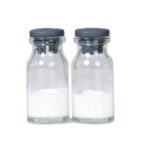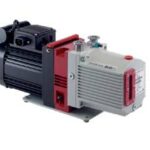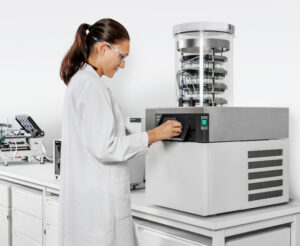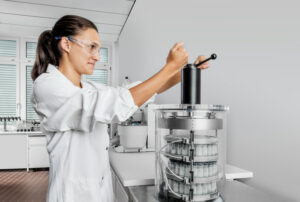Freeze Drying in the Laboratory – Tips and Tricks
Freeze Drying in the Laboratory – Techniques to Optimise your Processes
In the laboratory, freeze drying (also known as lyophilisation) stands out as a crucial technique for preserving and analysing delicate samples. As research scientists aim for precision and efficiency, mastering the art of freeze drying becomes paramount.
Within this blog, BUCHI experts have put together some techniques to optimise your freeze drying processes, ensuring the integrity of your research samples while elevating overall laboratory productivity.
BUCHI, a market leader in laboratory evaporation, offers a range of freeze drying solutions applicable across multiple sectors. From from research and development to quality control, our solutions are used in academia, research, food and nutrition, pharmaceuticals, biopharma, and clinical settings.
Filling capacity of vials and positioning of temperature sensor
The following points should be observed when drying formulations in vials:
- Choose a vial size such that the product depth does not exceed 2 cm. Usual filling depths are approx. 1 cm.
- The sublimation front in the product migrates from top to bottom, i.e. above the ice boundary surface is the dried product and underneath it is the frozen product containing ice crystals that have not yet been sublimated.
- Sublimated ice molecules migrate through the dried product from bottom to top in the course of the drying process.
- For precise determination of the end point, the product sensor should be placed in the centre of the vial near the bottom.
Heat distribution across drying shelves
The BUCHI drying shelves have very accurate heat distribution to within +/-1 °C across the entire shelf. Nevertheless, the vials on the outside of the shelves dry more quickly than those in the middle. The reason is the ambient heat input through the acrylic dome. This can be minimized by a protective jacket. Accordingly, it is advisable to place the temperature sensor for determining the end point in a vial in the middle of the drying shelf.
However, it is also important to be aware that the thermocouple transmits additional heat to the product. Therefore, extending the drying time by between 30 min and 2 hrs depending on the product is recommended in order to ensure that all ice is removed from the entire batch.
Vacuum pump service interval
The inspection window of the rotary vane pump should be checked every 24 hours. If a change in the colour of the oil is discernible, it is advisable to change the oil. Normally, the oil in the rotary vane pump is changed every 500 hrs. After every 1,000 hours of duty it is advisable to check and clean the motor fan grille, the gas ballast valve and the pump as a whole. The slide valve should be replaced every 10,000 hours of duty.
Methods for determining the end point of primary drying
Comparative pressure measurement between a capacitive pressure gauge and a Pirani sensor can define the endpoint. Whereas the capacitive pressure gauge functions independently of the gas type and always indicates the true pressure in the drying chamber, the Pirani sensor is calibrated to a specific gas and measures only relative figures according to gas type.
Calibrated to N2, the Pirani sensor indicates higher values than the capacitive pressure gauge in response to the presence of water molecules in the chamber. As the concentration of water molecules decreases, the detected value of the Pirani sensor progressively becomes closer to that of the capacitive pressure gauge until they become equal at the end point.
Pressure rise test is accomplished by closing the valve between the product and condenser chambers. When the two chambers are isolated, the pressure in the product chamber rises due to the on-going sublimation of the water molecules. The pressure rise curve progressively levels off as the water molecule concentration decreases. The end point is the point at which no further pressure rise is dicscernible.
Stoppering to close your vials under required conditions
The height of the shelves in the BUCHI top-mounted Freeze Drying rack is adjustable in a wide range. That enables the use of a unique stoppering system for all shelf drying racks. The system has a self-sealing mechanism and stoppering can be achieved under vacuum and ambient pressure conditions even with inert gas. In contrast to conventional systems, the shelves therefore do not need a hole in the middle of the round shelves.
Cleaning and waste-water handling
Cleaning of the double condensers is carried out automatically when fully loaded. Thus, the waste water is directly discharged into a drain or collecting vessel. There is a fill level sensor in the collecting vessel that informs the user when the vessel needs to be emptied.


